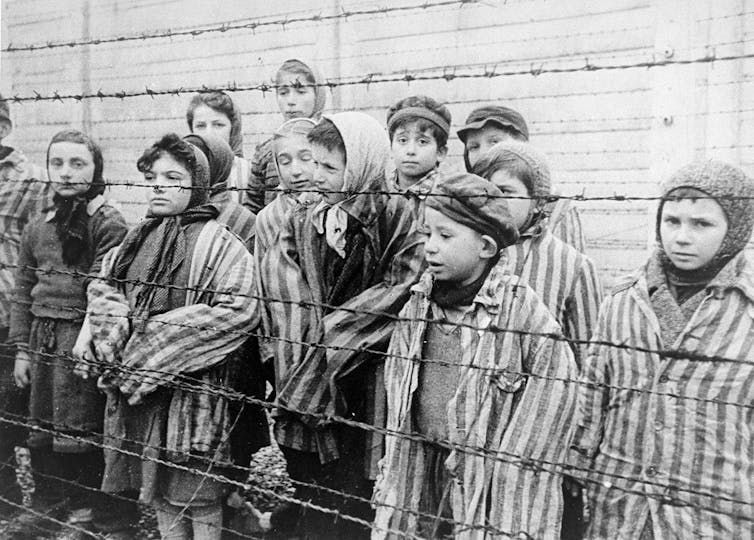Aristotle Kallis
Professor of Modern and Contemporary History

Extraordinary evil involves a total moral collapse across society caused by failure of individual humanity and ethical judgment. This was the conclusion of the philosopher Hannah Arendt after witnessing the trial of Adolf Eichmann – the chief architect of the Holocaust – in Jerusalem.
Medicine, which is supposed to alleviate human suffering, became a willing accomplice in Nazi mass murder. Although medical professionals had been involved in abusive practices on human subjects and populations before, under Nazi rule the scale of their professional lapse was extreme in every respect.
Even before they launched the “final solution” against the Jews, Nazi authorities had already engaged in a covert, murderous project directed at people with disabilities in Germany. The T-4 “euthanasia” programme marked a terrifying climax of trends in medicine that was long in the making – and not unique to Germany.
These and other related failings of medical practice in the Third Reich were the subject of the Lancet Commission on Medicine, Nazism, and the Holocaust. The conclusions were recently published in a comprehensive report. The report was accepted for publication before October 7 – the date of the Hamas attack on Israel.
The report highlights the urgent need to expand our understanding of the history of medicine in Nazi Germany in order to “emphasise the unique opportunities and responsibilities of health professionals” to eliminate antisemitism and racism, and to protect “vulnerable populations against stigmatisation and discrimination”.
Learning about this dark episode in the recent past is not only crucial for fostering a “history-informed professional identity” but serves as a poignant cautionary tale of the fragility of core values of healthcare.
Uncomfortable truths
The report highlights uncomfortable truths, not only for Germany at the time but for humanity as a whole, then and now.
Once the second world war had ended and the full horror of the crimes perpetrated by the Nazi regime started to come to light, it was tempting to attribute all these excesses to the small clique of fanatical Nazis and staunch ideological followers, motivated by extreme racial hatred. This was the logic behind the post-war international trials set up to bring to justice political, military and medical elites of the Nazi regime.
Yet the Nazis did not invent modern racism – medical or otherwise. Eugenics, the belief in the ability of science to achieve human and social perfection through invasive interventions in genetics, was the product of 19th-century Western modernity. So was the development of a modern global pseudoscience of “racial hygiene” that combined empirical research with long-standing prejudices and colonial mindsets.
Germany was already part of this broader trend. It was on the cutting edge but not a lone pioneer, let alone an outlier, in the 1930s. There were mainstream figures and doctors around the world who applauded the supposed boldness of Hitler’s regime when it embarked on early experiments with forced sterilisations.
Inspiration for many Nazi racialist policies came from elsewhere, not least the Western world.
Uncomfortable myths
Still, under the Nazi regime medicine became “murderous science” on an unprecedented scale.
More than half of German doctors had joined the Nazi party. This proportion was significantly higher compared with most other professional groups.
When the T-4 programme went into full murderous gear in 1940-41, it was overseen by distinguished research scientists in world-class establishments and medical staff across several institutions in Germany, who translated Hitler’s order into medical practice.
Doctors, nurses and care staff, as well as managers and “desk murderers” formed a chain of complicity that made all these murders possible and the system so brutally efficient.
Such a catastrophic failure of medical education, codes of practice, and individual moral judgment cannot be comprehended as the result of ideological fanaticism of the few and coercion of the many. Far from being a case of “a few bad apples”, the complicity of medical practitioners to Nazi evil was extensive, sustained and very often willing.
From the early forced sterilisation programmes to the horrific medical experiments conducted within the camps and the mass starvation of enemy prisoners of war, long-standing prejudices fed the Nazi machine, ensuring high levels of willing complicity or passive acceptance across all stages of implementation.
Cautionary message
All this matters for appreciating how eugenics and biological racism were allowed to run amok under the Nazi rule. It also carries a cautionary message that is relevant for the contemporary world.
Today, scientific progress, cultural sensibilities and ethics often find themselves on a collision course. Recent advances in medical science and technology confront us with unprecedented possibilities but also complex dilemmas about patient safety and the value of human life.
The Lancet report highlights how learning about the history of health practice can prepare medical practitioners for confronting these and other challenges about the role of their profession in the 21st century.
More broadly, history-informed identities can also help undermine the deeper cultural and social biases that often weaken the moral resolve of whole societies, medical professionals included, and make the most radical form of evil possible, in small, unspectacular steps.
This article is republished from The Conversation under a Creative Commons license. Read the original article.








